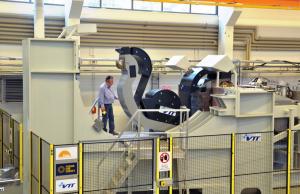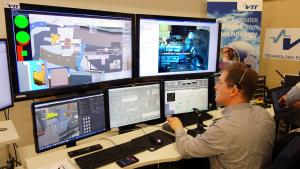Like inserting a ship into a bottle
In Tampere, Finland—a small town two hours north of Helsinki—an important demonstration took place for ITER this past winter.

They came from Barcelona, where the European Domestic Agency¹ for ITER is located, and from ITER Headquarters in southern France. A dozen specialists had made the trip to witness the culmination of twenty years of effort, ingenuity and technological innovation: the insertion of a ten-ton component into a replica of an ITER vacuum vessel section.
In watching the proceedings, it's easy to think of the mariners of old who managed to insert a model ship, with fully deployed sails, into a bottle — another operation requiring careful planning, dexterity and millimetric precision within severe space constraints. But whereas the mariners didn't think of removing their models once they were in place, the 10-ton ITER component will have to be replaced at least once over the project's lifetime. After demonstrating insertion, it will be necessary to demonstrate removal.
The huge piece of equipment on the test stand is one of the 54 cassettes that make up the ITER divertor — a nine-metre ring situated at the bottom of the vacuum vessel and directly exposed to some of the highest heat fluxes of the machine
During tokamak assembly, the nine sectors of the vacuum vessel will be installed and welded together before the installation of the divertor cassettes can begin. That leaves only three relatively narrow (and blind) passageways into the vacuum vessel for divertor installation.
The operation underway in the vast hall of the VTT Technical Research Centre of Finland is the last in a series of demonstrations that were initiated four years ago. "The last and the most delicate," emphasizes Mario Merola, ITER Internal Components Division head. "We are simulating the installation of one of the three central cassettes that will close the circular arrangement of the divertor assembly.
A 20-metre-long cassette multifunction mover, equipped with rails and hydraulic motors, progressively transports the mockup divertor cassette to its final dockings inside of a 1:1 scale section of the ITER vacuum vessel. The last metres are hidden from the operators' eyes, just like they will be during ITER assembly when the divertor cassettes are transported through the lower ports into position. Between the 10-ton component and the narrow passageway, there are only a few millimetres of space.
In the control room, VTT senior researcher Hannu Saarinen sits, eyes riveted to an array of screens. To his left, a large virtual image shows the progression of the cassette inside the port; on smaller screens, below, numbers and figures scroll endlessly. Without a way to fit a camera into the tunnel, all information is based on sensors and virtual reality — without it, operators would be blind. Thanks to this real-time information, Hannu knows at each instant what forces are at play on the structure and what tiny distortions are caused by the movement. "More than 80 percent of the operation is pre-programmed; we use the joystick only for small adjustments."
Hannu, his joystick and his screens are sitting only a few metres from activity on the mockup. But they could just as well be separated by millions of kilometres of space or thousands of leagues of ocean depth. "This has been one of the biggest challenges of the operation: working with pure models without any visual connexion," says VTT Executive Vice-President Jouko Suokas. "But it has been an excellent platform to increase our competency in virtual reality and control software. This expertise is now being transferred to industry, which was one of the key reasons for our involvement in this project."
In the "laboratory conditions" provided by the test bed in Tampere, the operation was a model of perfection. Years before the 54 divertor cassettes will be inserted into the ITER vacuum vessel, work is beginning now so that — in the industrial environment of ITER assembly — the same level of perfection is achieved.
"What [has been demonstrated] here today," says Carlo Damiani, the European Domestic Agency's Project Manager for remote handling systems, "is the beginning of a brand-new technology chapter written thanks to ITER. We need to design and manufacture remote handling systems that are resistant, agile and precise. It's an opportunity for industry, SMEs and laboratories to think out of the box, innovate in engineering, and shape the future fusion reactors."
Beyond ITER or fusion, the potential applications for this type of robotic system are huge. Just like with other high-tech systems — superconductivity, cryogenics, materials — the high demands of ITER are bringing known technologies to the limits of their feasibility.
¹Europe's contribution to ITER remote handling systems is in the range of EUR 250 million. EUR 40 million of this has gone to the development of divertor cassette insertion and removal technologies.



